
The Hall Art Foundation is pleased to announce an exhibition by American artist Richard Artschwager to open at its galleries in Reading, Vermont from 11 May – 1 December 2019. Artschwager was an American painter, sculptor and draftsman. Although he has been associated with Pop Art, Conceptual Art, Minimalism and Photorealism, he is best known for forging a path of stylistic independence. Artschwager’s work confounds our expectations of the ordinary through a heterogeneous body of whimsical work that references everyday objects, symbols, people and places, and is often made from unconventional and industrial materials. This exhibition will include approximately forty paintings, sculptures and works on paper from the Hall Collection that span Artschwager’s career from 1964 to 2011.
Artschwager’s groundbreaking discovery in the 1960s was the use of commercial-grade, synthetic products for his art. His use of Formica - an inexpensive, readymade veneer for cabinets - involved the transfer of a two-dimensional surface (often a photographic representation of wood) onto a three-dimensional form. Artschwager was interested in the visual paradox of the material as “a picture of a piece of wood”: “If you take that and make something out of it, then you have an object. But it’s a picture of something at the same time it’s an object.” In the early work Mirror (1964), an unreflective yellow panel is set in a mahogany-colored Formica frame and mounted on the wall to mimic the scale, shape and form of a mirror. Chest of Drawers (1964) consists of a simple plywood block inlaid with pieces of faux wood-grain Formica. In both cases, the functionality of familiar domestic objects is negated and rendered uncanny. These unique artworks conflate typical classifications of furniture, sculpture, painting and photograph. Unlike many of his Minimalist contemporaries who were also making hard-edged, geometric works at the time, Artschwager’s sculptures retain a wry element of playfulness and relatability.
In the early 1960s, Artschwager began using found images – particularly from newspapers – as source material for grisaille paintings. In addition to Formica, Artschwager’s other favored synthetic material was Celotex, a construction material designed for ceiling insulation made of dried sugarcane fibers pressed into a stiff board. Celotex is heavily textured, and Artschwager often employed the rough surface for his paintings. In works like Woman on Swing (Portrait of Ruth Dworken) (1969), imagery from a found photograph is transposed in acrylic onto a Celotex board through a grid system devised by Artschwager to faithfully enlarge his source material onto his painting supports. The work’s surface retains a texture similar in appearance to bumpy and slightly blurred newspaper print while also having the tactility of handmade paper.
Artschwager is also well known for creating sculptures based on punctuation marks and Morse code. In works like Untitled (Quotation Marks) (1980) and Working Model for Drop Drop (1988), greatly enlarged symbols of punctuation are made into autonomous sculptures. Artschwager has described his punctuation pieces as wanting to inflect objects and spaces the way real (!) punctuation inflects the abstract objects and spaces of written language. Similarly, Artschwager’s “blps”, lozenge-shaped forms inspired by Morse code and made of painted wood or rubberized horse hair, were made to function as conceptual focal points.
Towards the end of his career, Artschwager turned his focus to images of an open road leading out to a horizon. Artschwager grew up in the American Southwest in Las Cruces, New Mexico where the dramatic landscape and abundant topography left a lasting impression. Beginning in the late 2000s and until his death, Artschwager returned to color in paintings and works on paper and produced a group of vibrant pastel drawings based on the desert landscape – a stark contrast to the cool detachment and gray palette of the work for which he had previously been known. Works such as Small Houses (2011) consist of variously textured horizontal bands of blue, green and orange stacked on top of each other, ultimately culminating in three small houses set against a vast sky.
Richard Artschwager was born in 1923 in Washington, D.C. After serving in World War II, he received a BA from Cornell University in New York. He arrived in New York City in the late 1940’s and spent a period studying with the French Cubist painter, Amédée Ozenfant. Having a family and needing a steady salary, Artschwager began to produce furniture in 1953, and by 1956, was building mass-quantities for commercial sales. After a disastrous workshop fire at the end of the decade, he began making sculpture using leftover industrial materials, then expanded into painting, drawing, site-specific installation, and photo-based work. Since his first show in New York in 1959, he has had numerous solo exhibitions in Europe and North America. The Whitney Museum of American Art in New York organized his first major survey in 1988. Subsequent exhibitions of his work were presented at the Centre Pompidou, Paris (1989), the Fondation Cartier, Paris (1994), Serpentine Gallery, London (2001), Museum für angewandte Kunst (MAK), Vienna (2002), the Museum of Contemporary Art, North Miami (2003), Deutsche Guggenheim, Berlin (2003), Kunstmuseum Winterthur, Switzerland (2003), and Contemporary Art Museum, Saint Louis (2010), among others. In 2012, the Whitney Museum of American art organized a major retrospective of his work that traveled to the Hammer Museum, Los Angeles, Haus der Kunst, Munich, and Nouveau Musée National de Monaco. His work can be found in museum collections worldwide. Richard Artschwager died in 2013 in Albany, New York at the age of eighty-nine.
The Hall Art Foundation in Reading, Vermont is open weekends by appointment.
Appointments are available Saturdays and Sundays at 11 AM and 2 PM.
Admission: $10 pp
The First Friday of every month, from 5 - 8 PM, we also welcome visitors to view our exhibitions without a guide and at their own pace. Admission is free!
Donations to help support our programming are always appreciated.
544 VT Route 106
Reading, VT 05062
For more information and images, please contact the Foundation’s administrative office at + 1 802 952 1056 or info@hallartfoundation.org.
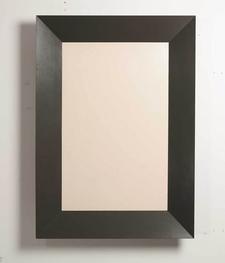
Richard Artschwager
Mirror, 1964
Formica on wood
60 x 43 x 7 in. (152.5 x 109 x 17.5 cm)
Hall Collection
Courtesy Hall Art Foundation
© the artist
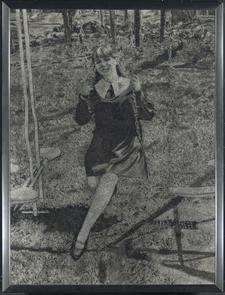
Richard Artschwager
Woman on Swing (Portrait of Ruth Dworken), 1969
Acrylic on Celotex in artist's frame
50 x 38 in. (128 x 97 cm)
Hall Collection
Courtesy Hall Art Foundation
© the artist
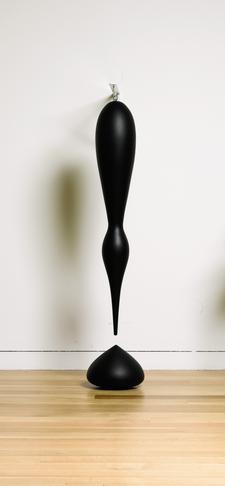
Richard Artschwager
Working Model for Drop Drop, 1988
Polychromed wood, in 2 parts; Edition 1/3
47 x 7 x 7 in. (119 x 18 x 18 cm)
Hall Collection
Courtesy Hall Art Foundation
© the artist

Richard Artschwager
Journal 1, 1991
Formica and acrylic on wood
94-1/2 x 92 x 1-1/2 in. (240 x 234 x 4 cm)
Hall Collection
Courtesy Hall Art Foundation
© the artist
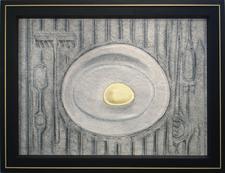
Richard Artschwager
Rights of Man, 1991
Acrylic on fiber panel and wood in artist's frame
47-1/2 x 61-1/2 in. (121 x 156.5 cm)
Hall Collection
Courtesy Hall Art Foundation
© the artist
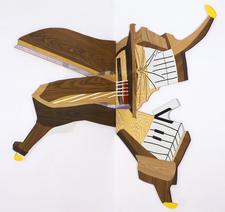
Richard Artschwager
Splatter Piano, 1999
Formica and acrylic on wood
78 x 88 in. (198 x 223.5 cm)
Hall Collection
Courtesy Hall Art Foundation
© the artist
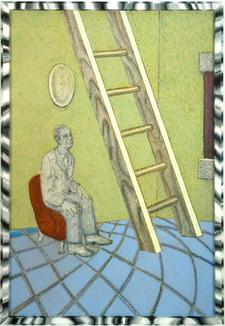
Richard Artschwager
The Ladder, 2004
Acrylic on fiber panel in artist's frame
74 x 51 in. (188 x 130 cm)
Hall Collection
Courtesy Hall Art Foundation
© the artist
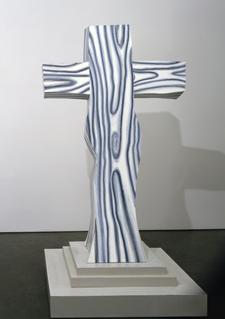
Richard Artschwager
4th Cross, 2004
Acrylic on plywood
79 x 40 x 42 in. (201 x 102 x 107 cm)
Hall Collection
Courtesy Hall Art Foundation
© the artist
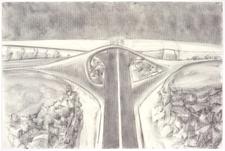
Richard Artschwager
Untitled (Overpass), 2005
Charcoal on paper
25 x 38 in. (64 x 96 cm)
Hall Collection
Courtesy Hall Art Foundation
© the artist
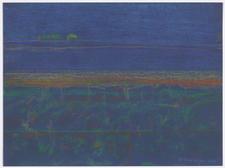
Richard Artschwager
Small Houses, 2011
Pastel on blue paper
20 x 25-1/2 in. (50 x 65 cm)
Hall Collection
Courtesy Hall Art Foundation
© the artist
